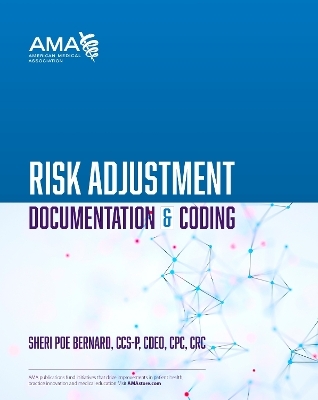
Risk Adjustment Documentation & Coding
Seiten
2018
American Medical Association (Verlag)
978-1-62202-733-0 (ISBN)
American Medical Association (Verlag)
978-1-62202-733-0 (ISBN)
- Titel ist leider vergriffen;
keine Neuauflage - Artikel merken
Detailed documentation and compliant diagnosis coding are critical for proper risk adjustment. Risk Adjustment Documentation & Coding provides risk adjustment parameters to improve documentation related to severity of illness and chronic diseases, and code abstraction designed to improve diagnostic coding accuracy without causing financial harm to the practice or health facility.
Risk adjustment practices consider chronic diseases as predictors of future healthcare needs and expenses. Detailed documentation and compliant diagnosis coding are critical for proper risk adjustment.
Risk Adjustment Documentation & Coding provides:
Risk adjustment parameters to improve documentation related to severity of illness and chronic diseases.
Code abstraction designed to improve diagnostic coding accuracy without causing financial harm to the practice or health facility.
The impact of risk adjustment coding—also called hierarchical condition category (HCC) coding—on a practice should not be underestimated. More than 75 million Americans are enrolled in risk-adjusted insurance plans. This population represents more than 20% of those insured in the United States. Insurance risk pools under the Affordable Care Act include risk adjustment. CMS has proposed expanding audits on risk adjustment coding. Meticulous diagnostic documentation and coding is key to accurate risk-adjustment reporting. This book will help align the industry though an objective compilation and presentation of risk adjustment documentation and coding issues, guidance, and federal resources.
Features and Benefits:
Five chapters delivering an overview of risk adjustment, common administrative errors, best practices, topical review of clinical documentation improvement and coding for risk adjustment alphabetized by HCC group, and guidance for development of internal risk adjustment coding policies.
Six appendices offering mappings, tabular information, and training tools for coders and physicians that include an alphanumeric mapping of ICD-10-CM codes to HCCs and RxHCCs and information about Health and Human Services HCCs versus Medicare Advantage HCCs.
Learning and design features:
Vocabulary terms highlighted within the text and conveniently defined at the bottom of the page.
Advice/Alert Notes” that highlight important advice from the ICD-10-CM Guidelines for Coding and Reporting.
Key Coding Concepts” that offer the advice published in ICD-10-CM Coding Clinic for ICD-10-CM and ICD-10-PCS.
Sidebars that detail measurements pertinent to risk adjustment seen in physician documentation, eg., cancer staging, disability status, or GFRs.
Coding Tips that guide coders to the right answers (using terminology and ICD-10-CM Index and Tabular entries) or provide cautionary notes about conflicts in the official ICD-10-CM guidance.
Clinical Examples that underscore key documentation issues for risk adjustment.
Clinical coding examples that provide snippets or full encounter notes and codes to illustrate key issues for the HCC or RxHCC.
Risk Adjustment Documentation & Coding
Documentation tips highlight recommendations to physicians regarding what should be included in the medical record or how ICD-10-CM may classify specific terms.
Examples that explain difficult concepts and promote understanding of those concepts as they relate to a section.
call outs that provide quick facts.
Extensive end-of-chapter Evaluate Your Understanding sections that include multiple-choice questions, true-or-false questions, and Internet-based exercises.
Downloadable slide presentations for each chapter that cover key content and concepts.
Educator resources that include two tests; a test bank containing 100 questions, case studies, and answers with rationales; and a mock risk adjustment certification exam with 150 questions.
Risk adjustment practices consider chronic diseases as predictors of future healthcare needs and expenses. Detailed documentation and compliant diagnosis coding are critical for proper risk adjustment.
Risk Adjustment Documentation & Coding provides:
Risk adjustment parameters to improve documentation related to severity of illness and chronic diseases.
Code abstraction designed to improve diagnostic coding accuracy without causing financial harm to the practice or health facility.
The impact of risk adjustment coding—also called hierarchical condition category (HCC) coding—on a practice should not be underestimated. More than 75 million Americans are enrolled in risk-adjusted insurance plans. This population represents more than 20% of those insured in the United States. Insurance risk pools under the Affordable Care Act include risk adjustment. CMS has proposed expanding audits on risk adjustment coding. Meticulous diagnostic documentation and coding is key to accurate risk-adjustment reporting. This book will help align the industry though an objective compilation and presentation of risk adjustment documentation and coding issues, guidance, and federal resources.
Features and Benefits:
Five chapters delivering an overview of risk adjustment, common administrative errors, best practices, topical review of clinical documentation improvement and coding for risk adjustment alphabetized by HCC group, and guidance for development of internal risk adjustment coding policies.
Six appendices offering mappings, tabular information, and training tools for coders and physicians that include an alphanumeric mapping of ICD-10-CM codes to HCCs and RxHCCs and information about Health and Human Services HCCs versus Medicare Advantage HCCs.
Learning and design features:
Vocabulary terms highlighted within the text and conveniently defined at the bottom of the page.
Advice/Alert Notes” that highlight important advice from the ICD-10-CM Guidelines for Coding and Reporting.
Key Coding Concepts” that offer the advice published in ICD-10-CM Coding Clinic for ICD-10-CM and ICD-10-PCS.
Sidebars that detail measurements pertinent to risk adjustment seen in physician documentation, eg., cancer staging, disability status, or GFRs.
Coding Tips that guide coders to the right answers (using terminology and ICD-10-CM Index and Tabular entries) or provide cautionary notes about conflicts in the official ICD-10-CM guidance.
Clinical Examples that underscore key documentation issues for risk adjustment.
Clinical coding examples that provide snippets or full encounter notes and codes to illustrate key issues for the HCC or RxHCC.
Risk Adjustment Documentation & Coding
Documentation tips highlight recommendations to physicians regarding what should be included in the medical record or how ICD-10-CM may classify specific terms.
Examples that explain difficult concepts and promote understanding of those concepts as they relate to a section.
call outs that provide quick facts.
Extensive end-of-chapter Evaluate Your Understanding sections that include multiple-choice questions, true-or-false questions, and Internet-based exercises.
Downloadable slide presentations for each chapter that cover key content and concepts.
Educator resources that include two tests; a test bank containing 100 questions, case studies, and answers with rationales; and a mock risk adjustment certification exam with 150 questions.
Sheri Poe Bernard, CCS-P, CDEO, CPC, CRC, is one of the nation’s leading developers of medical coding curricula and referential material. An expert communicator of coding concepts, Bernard works as a writer, public speaker and risk adjustment consultant in coding, training, and clinical documentation improvement. She brings more than 25 years of experience in coding and reimbursement publishing, training, and test development to the American Medical Association as one of its newest authors. In addition to this book, her AMA titles include Netter’s Atlas of Surgical Anatomy for CPT Coding and ICD-10-CM Chronic Disease Cards.
| Erscheinungsdatum | 21.07.2018 |
|---|---|
| Verlagsort | Chicago |
| Sprache | englisch |
| Maße | 152 x 229 mm |
| Gewicht | 1230 g |
| Themenwelt | Schulbuch / Wörterbuch ► Erwachsenenbildung |
| Medizin / Pharmazie ► Gesundheitswesen | |
| ISBN-10 | 1-62202-733-7 / 1622027337 |
| ISBN-13 | 978-1-62202-733-0 / 9781622027330 |
| Zustand | Neuware |
| Haben Sie eine Frage zum Produkt? |
Mehr entdecken
aus dem Bereich
aus dem Bereich
Deutsch für die Integration B1.1 Kurs- und Arbeitsbuch
Buch | Softcover (2022)
TELC (Verlag)
12,90 €
Deutsch für die Integration A1.1 Kurs- und Arbeitsbuch
Buch | Softcover (2022)
TELC (Verlag)
12,90 €
Buch | Softcover (2022)
Mission: Weiterbildung. GmbH (Verlag)
46,95 €


